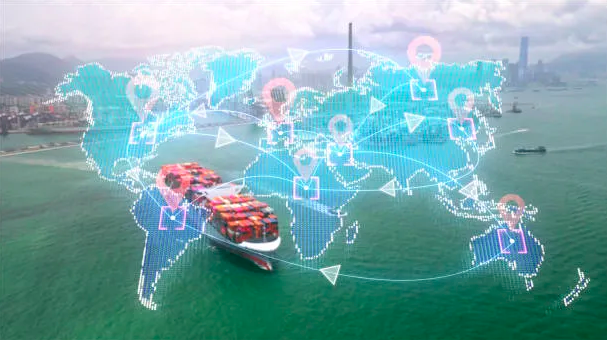In 2007, China began implementing the strategy encapsulating the new world reality that “data is the new oil“. Through the control of data and information, China could gain a dominant position within the global economy.
Initially started as a pilot program to facilitate road-based trade within China, the strategy morphed in 2010 to engage trade with China’s nearest regional trading partners. It was embedded into what is known as the Regional Comprehensive Economic Partnership (RCEP).
These developments went unnoticed by those in the US / EU trade block allowing China to gain a significant advantage in developing common data standards. Common data standards are essential for efficient data exchange across business and country interfaces. Without these, seamless trade across jurisdictions would not be possible. It was not irrational for Xi Jinping to take the next step of incorporating data / technology as a factor of production.
The headline, courtesy of the Global Times, captures the view from within the mainland. Ironically, the quote used in the headline is deeply embedded within the article. Perhaps a Freudian slip spotlight on China’s ambitions of coercive weaponization through Logink.
The opinion piece was published as a response to the US Pentagon recent banning of naval vessels using port facilities with a digital interface with Logink. It could also be said that the piece was an attempt to downplay the potential economic power of the platform. It sidesteps issues of data security, ownership, transparency, integrity and associated risk profile as global shipping moves towards “smart ports.”
As knowledge of the Logink platform grows internationally, China has stepped up its counter-intelligence through the Caixin Global news agency. As recently as 23 March 2024, it boldly proclaims that the Party will relax requirements for outward cross border data transfer with scope of information required for security review being narrowed. What China’s Cyberspace Administration does not address is the interface between these regulations and the plethora of national interest and security legislation currently in place.
Is the system as benign as Beijing claims?
Whilst China claims it is merely a tool to improve efficiency and reliability of maritime transport, closer scrutiny reveals a more robust underbelly. Context is provided by the 2017 announcement stating that Logink offers “opportunities” for the Party to shape markets in the Internet era. Expanding this context is the 2020 policy mandating data “to be included in factors of production”. Data was elevated to having the same value as capital, land, labor. It was argued that data has a multiplier effect on efficiency but needed a framework of management and protection through unified data standards and data sharing for the data real power to be realized. Simply put, Logink is not a passive data aggregation platform but has been designed to give China a dominant position using data and information needed for global trade.
By embedding Logink into port and terminal operating systems, China has created a dependence on Chinese operating systems. China has quietly been strengthening this position when one considers that it now has data supplied by 450,000 users within logistics providers servicing trade with China. Logink now has a network of up to ninety-five ports, thirty-one of which are in the EU. Unfortunately, the opaque nature of Logink makes it difficult for port owners to recognize that China effectively now operates fifty-two ports outside the mainland. Extending the level of control are the ownership rights in a further 35 Ports through Chinese private owned enterprises.
In a sense it is a little too late as Logink secured global leadership in this technology space. As the platform moves to a cloud based IOT enabled system, the system gives China increasing economic power whilst others play catch up. Strategically the focus has shifted from embedding it into port and terminal operating systems to other modes of logistics and transport.
An example of Logink’s proliferation into other modes of transport is Alibaba’s Cainiao system. It operates in two hundred logistic warehouse hubs internationally and is aided by the CargoSmart tracking system that tracks most global container ships.
The risks and potential for data manipulation and coercion were initially set out in my article published in 2021, with an updated version in 2022.
Logink’s opaqueness can be attributed to China being allowed to help set international data standards. Initial debate around data standards and exchange was built on meritocratic processes in technical and data sharing. Standards creation shifted to one of logistics / supply chain integrity. Integration was made possible through China’s Transport and Telecommunications and Information Center partnering with the International Port Community Systems Association (IPSCA). The IPCSA has created data sharing standards for all Ports globally.
Shaping ICT international data standards by China’s Ministry of Transport gives China a great degree of ownership of trade and cargo movement data. It has gone beyond a means to facilitate a more efficient and effective data exchange between trading partners. From a trade and commerce perspective, the platform has morphed way beyond the initial single window platform. As the platform moves to a cloud based IOT enabled system, the system gives China increasing economic power whilst others play catch up.
What has been ignored in the discussion around data standards are the forms of government wanting to exchange data. Governments in an open digital trade system are not embedded in the commercial decision-making systems of private enterprise. China on the other hand has the Party with a direct involvement in all businesses with Chinese intertest. Compounding the concerns is the national security and data ownership laws and regulations that de-facto gives ownership of all data generated by China business to Beijing. Ownership captures all business whether onshore or offshore the mainland.
With the spread of Logink there is a greater risk of more focused economic coercion using data/ digitalization. The potential for significant supply chain disruption has given China greater capability to further its own ambitions.
The spread of Logink – China’s adherence to the principles in “The Art of War”?
The spread of the Logink platform has gone unnoticed and has followed the “Art of War” playbook. It has sought to “win the war without having to go into battle.” Today the war being fought is on the economic front. Logink is becoming increasingly visible as supply chain vulnerabilities are understood. There also appears to be an awakening that nations need to take steps preventing losing the economic war.
Smart port ambitions functioned as an effective smokescreen to deflect focus from China’s systematic and focused strategy for dominance. By creating an opaque system, two of Sun Tsu principles come to mind: “to know your enemy you must become your enemy,” “all warfare is based on deception.” Whilst the West chased smart port and supply chain nirvana through open systems, China could take advantage that few recognized Logink’s influence on the creation of international data exchange standards.
Operational in at least fifty countries, it now spans over ninety percent of the global logistics network. It has spread beyond port ecosystems and includes railways and other transport networks. It has morphed into a systematic encapsulation into four trading vectors, expanding the scope for Logink weaponization. These trading vectors are Business to Business (B2B), Business to Government (B2G), Government to Business (G2B) and Government to Government (G2G).
With greater cargo visibility across these vectors comes greater potential to use economic coercion. Ironically, trading partners aided this power by accepting the 2017 National Intelligence Laws, restricting foreign entities gaining access to data from China. In hindsight, an expensive sacrifice for market access…
A conspiracy theory?
Several examples point to economic coercion being used by China’s digital platforms. Australian coal shipments were left stranded when the origins of Covid-19 were questioned. China simply lost the digital handshake required for vessels to dock. China put the lost bill of lading and import certificates down to operating issues. Logink’s capability was used to give China plausible deniability in the use of coercion, allowing targeted economic warfare under the pretext of broader “port problems.”
2021 saw a China data blackout of the Automated Identification System (AIS) in the South China Sea. Only Chinese owned and operated vessels had tracking visibility when entering the South China Sea. This lack of cargo visibility created significant disruption on maritime operations and delivery for all other international shippers.
A more sinister military–civil fusion use of Logink was demonstrated at the Port of Gdynia in Poland in August 2023. Gdynia has NATO and Polish military depots in its precinct, just as Darwin Port in Australia has. In this incident a US vessel was prevented from delivering US Army equipment as the US vessel “protruded fifty meters“ into the Chinese side of the quay. It was denied docking permission.
Further concerns include security risks when airports use the Huawei Smart Airport architecture not just for airfreight, but also for military applications. Other illustrations exist with cranes using Huawei software being seen as problematic in US ports.
How extensive is the Logink Network?
Europe has the most extensive network, raising the risk profile of EU / China trade. With a Logink network of up to ninety-five ports, thirty-one of which are in the EU, fifty-two ports outside the mainland as well as having ownership rights in a further 35 Ports through Chinese private owned enterprises, China a digital handshake with just over half of all global container flows. This has been achieved through the “String of Pearl” strategy based on their military–civil fusion strategy in which the likes of Hong Kong’s Hutchinson Ports are being required to feed data into the Logink data network.
In Europe, China’s civil-military fusion strategy encompasses the ports of Antwerp, Zeebrugge, Valencia, Le Havre, Amsterdam, Gdynia and Stockholm. One should consider the significant trade security risks should China wish to block the Taiwan Strait through military intervention.
How has this been achieved?
The unintended consequence of allowing China to set International Data Standards was to give the State greater control over data exchange nodes. This has not been afforded to any other State.
Facilitating this expansion of China’s digital footprint has been the integration of Logink into port operating systems: CargoSmart, PortBase and CaiNao (Alibaba). Integration was made possible through China’s Transport and Telecommunications and Information Center partnering with the International Port Community Systems Association that has created data sharing standards for countries such as Spain, Germany and in the Middle East.
Concluding Remarks
Both the US and the EU have now responded to the growing risks. The EU has been more reluctant in its response, primarily due to the spread and integration of China’s trade within the EU. These disparate responses by the US and the EU will increasingly make global trade more complex. Now more than ever, businesses need to find ways to bypass the use of Logink or develop APIs that allow a secure interface between port operating systems. Failure to do so will make them vulnerable to business disruption as Logink is used as a focused economic coercive tool aimed at bringing China’s enemies into line.
The horse may well and truly bolt in terms of a weaponized Logink, but it is never too late to put systems in place that make you less vulnerable to economic coercion and / or trade manipulation.
Picture credits: Getty Images






Be First to Comment